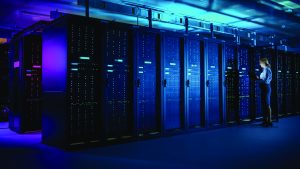With our buildings becoming more connected and digital – in a trend driven by the demand for sustainability – comes the need for greater efficiency to help keep costs under control while emphasizing improved occupant safety and comfort.
Digitization and electrification are key enablers for creating high-efficiency, low- to zero-emission buildings. They impact each stage in a building’s life cycle from design/build through operations and maintenance.
These important trends are bridging the gap between information technology (IT) and operations technology (OT) and enabling building operators to leverage each system’s data to optimize performance. However, ensuring building performance success begins with collaboration between electrical and mechanical designers. By doing so and equipped with digital tools, they can better monitor and optimize infrastructure construction while controlling costs.

What are digital buildings – and the IT/OT convergence?
This digital transformation has been enabled through the evolution of traditional power distribution, with the addition of meters, sensors, and other devices to enable real-time monitoring and control. The digitization also allows for integrating these capabilities into HVAC, lighting, and security systems.
For example, new space-conditioning controls use sensors to capture real-time data on occupancy and humidity to adjust room temperatures dynamically. By incorporating new monitoring devices at key points – like at individual circuits on an electrical panel – operations can gather data on energy use, power quality, and other critical operations facets to better understand how and where power is being used and to troubleshoot power problems.
The growing Importance of data is also creating new connections between what used to be the two IT and OT silos – the IT/OT convergence. Cloud-based analytics use artificial intelligence (AI) and machine learning (ML) to discover patterns and identify inefficiencies that could work against your customers’ efficiency and sustainability goals. Here, we see the shift from a more traditional design approach to a more outcome-oriented one focusing on delivering end-user value.
This might sound theoretical, but real-world examples of the growing IT/OT convergence surround us. Consider, for example, an office building’s connected lighting controls. Historically, IT departments focused on email and networking systems and would consider these functions firmly on the side of building operations – or OT.
However, if light switches or related smart sensors have IP addresses connected to a corporate Wi-Fi network, ensuring their secure operation is critical to the integrity of the IT system. It’s in this way that IT and OT responsibilities are converging.
Smart building technologies are being rapidly adopted, with the market estimated to reach $201 billion by 2031, with an estimated 90% of spend directed towards nonresidential properties. Building designers, owners, and operators recognize that these technologies, like Connected Room Solutions, can better manage occupant space and experience to cut energy use and support employee productivity, thus reducing the building’s total cost of ownership. For example, using data like CO2 levels to adjust HVAC operations can help employees stay alert, as can automating lighting systems to match the color characteristics of natural daylight. Considering that 75% of a building’s lifecycle cost is operational, investments that reduce those costs from the beginning can have a big impact over time.
Where design engineers come in
While owners may be aware of these building technologies and even understand their operational savings and sustainability benefits, they may lack in-house skills for implementation. Design engineers can fill this gap, providing system and device expertise to implement plans. This creates a new opportunity for consulting – not just designing – to become a bigger part of mechanical and electrical engineers’ responsibility.
Doing this right requires breaking down barriers between mechanical and electrical design processes to better capture and leverage data value from smart IoT-enabled infrastructures. Engineers must collaborate with architects, contractors, and other disciplines, using building information modeling (BIM) software to provide a 3D view of building systems as they’re developed. BIM provides realistic models of how those systems will perform once operational, meaning it can also estimate energy use compared to any relevant code, standard, or regulatory requirements. For this reason, BIM is becoming mandatory in some jurisdictions – with public sector projects in some areas of the United States, the UK, the Netherlands, South Korea, and other nations.
How to take advantage of new opportunities
Building technology evolves quickly, from devices to design software, making staying current on new cutting-edge capabilities challenging. And unfortunately, cyber security challenges are rising in parallel with these more positive developments. Evaluating and addressing risks from the beginning of design has become critical to securing operations once buildings are occupied. In both cases, though, firms that develop expertise in new product capabilities and design strategies for hindering cyber attacks have the chance to differentiate themselves from their competition.
This helps make the case that professional education is no longer a once-and-done proposition – lifelong learning is the new normal. Finding the right training resources can provide you with the background and skills to become a trusted partner that facility owners and managers need as they develop – or redevelop – their sustainability goals. Visit Schneider Electric’s Digital Buildings Training Program portal to begin your next educational journey. You can register here for our five-module course, “Digital Buildings. The Convergence of IT/OT,” exploring the new and realistic possibilities digital building design enables.
About the author

Leandro Bersan
Brazilian electrical engineer with over a decade of experience at Schneider Electric. His passion for engineering, digital innovation, and people led him to participate in an exchange program that took him to Australia, where he developed digital strategies for channel partners to finally became the local Channel Manager for Design Firms. He’s currently spearheading the global design firm channel.




Add a comment